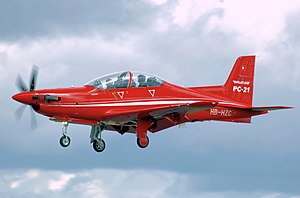Pilatus PC-21
| PC-21 | |
|---|---|
 |
|
| The PC-21 demonstrator lands at RIAT 2008, England. | |
| Role | Advanced Trainer aircraft |
| Manufacturer | Pilatus Aircraft |
| Designer | Pilatus Aircraft |
| First flight | 1 July 2002 |
| Introduction | April 2008 |
| Status | Active service |
| Primary users |
Swiss Air Force Republic of Singapore Air Force United Arab Emirates Air Force Royal Saudi Air Force |
| Produced | 2002–present |
| Number built | 131+ |
|
|
|
|
|
|
|
|
The Pilatus PC-21 is a single-turboprop, low-wing swept monoplane advanced trainer with a stepped tandem cockpit manufactured by Pilatus Aircraft of Switzerland.
In November 1997, Pilatus flew a modified PC-7 Mk.II in order to test improvements for a prospective next generation turboprop trainer. As a result of these tests, Pilatus elected to fund the development of a new training system in November 1998; development of the new trainer, designated as the PC-21, formally started in January 1999. The PC-21 would be developed and certified as a completely new training system, aimed at meeting future military customers' specifications in terms of capability and life-cycle costs for the next three decades.
A key aim for the PC-21 was to allow jet aircraft pilots to perform the majority of the training using the type, converting to jet-powered types only much later than typical contemporary practice, allowing operators to make substantial savings; in order to achieve this aim, the new trainer was required to have an expanded performance envelope in terms of aerodynamics, cockpit equipment, flexibility, and ease of maintenance. In May 2002, Pilatus announced that it aimed for the PC-21 to capture 50% of the global trainer aircraft market between 2005 and 2030.
From the start of the aircraft's development, Pilatus aimed for the type to have a predictable cost profile over its full lifespan. To meet this goal, the firm chose to incorporate modern materials, an innovative design concept, and full-scale fatigue analysis. Additionally, accompanying the aircraft itself are integrated training systems to meet the pilot's needs; the full package offered by Pilatus includes synthetic training devices, computer-based training, and classroom instruction. As a result of greater training effectiveness, pilots can graduate with fewer total training hours, reaching the frontline faster and at lower cost. In addition to pilots, various prospective aircrew, such as navigators, weapons officers, and electronic warfare operators, can be trained using the type's embedded simulation/emulation system.
On 30 April 2002, the rollout of the first PC-21 prototype was performed at Pilatus' factory in Stans, Switzerland; this aircraft conducted its first flight on 1 July of the same year. In May 2003, Pilatus management formally green-lit the program to proceed to full development. On 7 June 2004, a second PC-21 prototype, the construction of which having been delayed to incorporate improvements learnt from assembling the first, made its maiden flight. In December 2004, Switzerland's Federal Office for Civil Aviation granted type certification for the PC-21; civil certification was attained despite it being a military aircraft as this permitted civil maintenance procedures to be used as well as allowing the aircraft to be supplied under private finance arrangements. Individual Swiss military certification for equipment such as ejection seats has been applied as necessary.
...
Wikipedia
